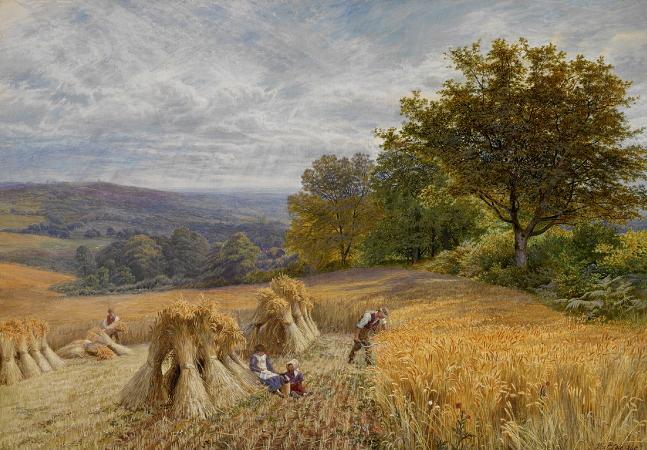Benjamin Williams Leader (1831 - 1923). Benjamin Williams Leader was an English landscape painter. Leader was born in Worcester as Benjamin Leader Williams, the son, and third child of eleven children, of notable civil engineer Edward Leader Williams and Sarah Whiting. His father was described as a non conformist dissenter and his mother was a Quaker-their marriage in an Anglican church resulted in them being disowned by the Society of Friends. Leader's father was a keen amateur artist-a friend of John Constable-and Benjamin would often accompany him on sketching trips along the banks of the River Severn. His brother, also Edward Leader Williams, later became a notable civil engineer who was knighted for his work, and is now mainly remembered for designing Manchester Ship Canal-which was to become the theme of Leader's largest painting. The family eventually came to reside at Diglis House-now a hotel. Leader was educated at the Royal Grammar School, Worcester, and initially worked at his father's office as a draughtsman while studying art in the evenings at the Worcester School of Design. In his free time he also did a lot of open air landscape painting. In 1854, at the age of 23, he was admitted as a student to the Royal Academy Schools in London, and, unusually, in his first year, had a picture accepted for exhibition there, Cottage children blowing bubbles, which was subsequently sold to an American buyer for E50-a large sum in those days. Subsequently, his work appeared in every summer exhibition at the academy until 1922, when Leader was 91 years old. He also had some early works exhibited at the National Institution of Fine Arts, Portland Place in 1857-58. The inspiration for these early works was the countryside around Worcester itself, the cottages, farmhouses, lanes, hedgerows and churches, so exceedingly picturesque and beautiful. However, Leader did not finish his course of studies at the R. A, nor did he need to-his paintings proved to be in great demand by wealthy buyers and he achieved an enviable degree of commercial success within only a few years of his first sale. In 1857 he changed his name to Benjamin Williams Leader to distinguish himself from the many other painters with the surname Williams. In autumn of that year he travelled to Scotland, and painted A Quiet pool in Glen Falloch-exhibited at the R. A. in 1859. That year was his most successful yet with four paintings hung at the Academy and all sold, one of the buyers being the art dealer Agnew's who bought much of his work during his lifetime. Such was the demand that much of his best work now went to private galleries and was never publicly exhibited. For the next 10 years, Leader divided his time painting between the Severn Valley, Worcestershire, and Wales, producing many canvases. Amongst them, Autumn's last Gleam was regarded as the best landscape in the Royal Academy's 1865 exhibition. In 1862 he moved home from Worcester to nearby Whittington which became a favourite sketching ground. In 1863, his work The Churchyard at Bettwys-y-Coed was purchased by the Prime Minister himself, William Gladstone. In August 1876, Leader married fellow artist Mary Eastlake and they went on to have 6 children-the first, Benjamin Eastlake Leader, also an artist, was killed in action during World War I. In 1881, February Fill Dyke was exhibited at the Royal Academy to great acclaim and Leader was made an associate in 1883, becoming a Royal Academician in 1898. In 1889, the family moved to Burrows Cross, Shere near Guildford, Surrey, a large mansion designed by Norman Shaw RA-Leader lived here until the end of his life. In that same year he was made a Chevalier of the Legion of Honour, an honour secured on the recommendation of French artist Meissonier. In 1914 he was made an Honorary Freeman of the City of Worcester in recognition of his services. Apart from his native Worcestershire and Wales, Leader also painted in other parts of Britain including Devon and Surrey and on the continent in Germany, Switzerland, France and Belgium. He died in Surrey in 1923. Leader's early works bore the influence of the Pre-Raphaelites with their attention to fine detail and emphasis on painting from nature en plein air. In his later years he adopted a looser style which was more impressionistic rather than being an exact copy of nature and this proved to be more popular.
more...














